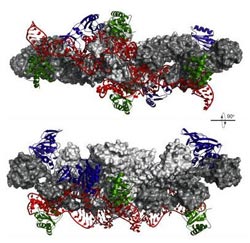Choreographed origami

Structure of the RNA-tagging machinery shows that only one pair of proteins (blue) can add tags to the RNA (red) at a time. Credit: EMBL/Carlomagno<br>
An important step in building ribosomes – the cell's protein factories – is like a strictly choreographed dance, scientists at the European Molecular Biology Laboratory (EMBL) in Heidelberg, Germany, have discovered.
To build these factories, other 'machines' inside the cell have to produce specific RNA molecules and fold them into the right shape, then combine the folded RNA with proteins to form a working ribosome. Like a budding origami artist pencilling in the folds, the cell uses tags called methyl groups to help mark where and how an RNA molecule should be folded.
In work published online today in Nature, the scientists have discovered that pairs of these tags are added in a specific order. The study combined nuclear magnetic resonance at EMBL and neutron scattering at the Institut Laue-Langevin (ILL) in Grenoble, France.
Led by Teresa Carlomagno at EMBL, the scientists were able to determine the 3D structure of the complex that adds methyl tags to the RNA, with the RNA molecules attached. They discovered that the different components of this tagging machine pair up and move in sequence, like dancers following a set choreography.
“We found that the complex has four copies of each protein, and four methylation sites on the RNA, but those methylation sites aren't all the same,” Carlomagno says. “They come in pairs, and one pair has to be methylated before the other.”
The fact that the pairs of tags have to be added in a particular order could be a way for the cell to control how the RNA is folded, and ultimately when and where ribosomes are formed, the scientists believe.
The study provides a detailed view of the complex in a form that's very close to what's found inside our cells. To obtain it, the EMBL scientists teamed up with Frank Gabel at the Institut Laue-Langevin (ILL) and the Institut de Biologie Structurale (IBS), both in Grenoble, France, to combine their expertise in nuclear magnetic resonance (NMR) with the Gabel lab's skills in small angle neutron scattering (SANS).
Media Contact
More Information:
http://www.embl.deAll latest news from the category: Life Sciences and Chemistry
Articles and reports from the Life Sciences and chemistry area deal with applied and basic research into modern biology, chemistry and human medicine.
Valuable information can be found on a range of life sciences fields including bacteriology, biochemistry, bionics, bioinformatics, biophysics, biotechnology, genetics, geobotany, human biology, marine biology, microbiology, molecular biology, cellular biology, zoology, bioinorganic chemistry, microchemistry and environmental chemistry.
Newest articles

Sea slugs inspire highly stretchable biomedical sensor
USC Viterbi School of Engineering researcher Hangbo Zhao presents findings on highly stretchable and customizable microneedles for application in fields including neuroscience, tissue engineering, and wearable bioelectronics. The revolution in…

Twisting and binding matter waves with photons in a cavity
Precisely measuring the energy states of individual atoms has been a historical challenge for physicists due to atomic recoil. When an atom interacts with a photon, the atom “recoils” in…

Nanotubes, nanoparticles, and antibodies detect tiny amounts of fentanyl
New sensor is six orders of magnitude more sensitive than the next best thing. A research team at Pitt led by Alexander Star, a chemistry professor in the Kenneth P. Dietrich…





















